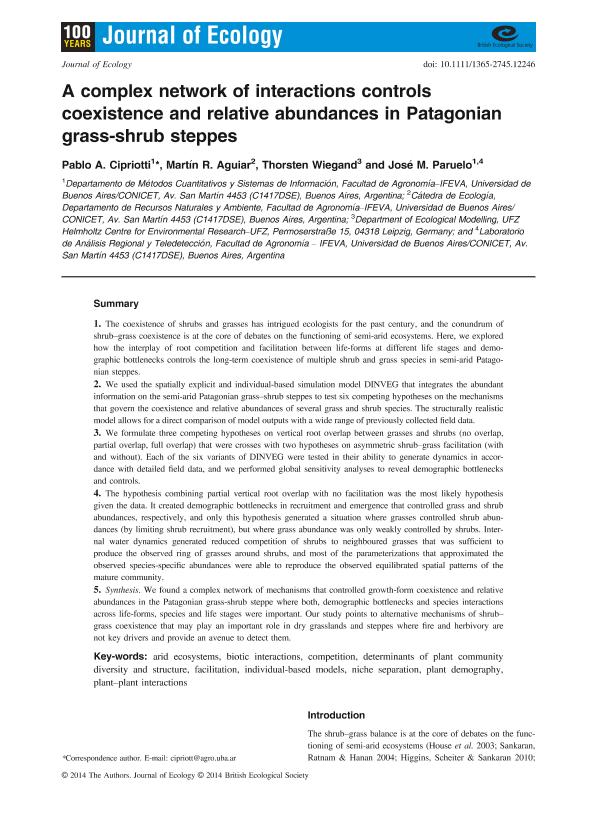Artículo
A complex interaction networks controls coexistence and relative abundances in grass-shrub Patagonian steppes
Fecha de publicación:
02/2014
Editorial:
Wiley
Revista:
Journal of Ecology
ISSN:
0022-0477
Idioma:
Inglés
Tipo de recurso:
Artículo publicado
Clasificación temática:
Resumen
1. The coexistence of shrubs and grasses has intrigued ecologists for the past century, and the conundrum of shrub-grass coexistence is at the core of debates on the functioning of semi-arid ecosystems. Here, we explored how the interplay of root competition and facilitation between life-forms at different life stages and demographic bottlenecks controls the long-term coexistence of multiple shrub and grass species in semi-arid Patagonian steppes. 2. We used the spatially explicit and individual-based simulation model DINVEG that integrates the abundant information on the semi-arid Patagonian grass-shrub steppes to test six competing hypotheses on the mechanisms that govern the coexistence and relative abundances of several grass and shrub species. The structurally realistic model allows for a direct comparison of model outputs with a wide range of previously collected field data. 3. We formulate three competing hypotheses on vertical root overlap between grasses and shrubs (no overlap, partial overlap, full overlap) that were crosses with two hypotheses on asymmetric shrub-grass facilitation (with and without). Each of the six variants of DINVEG were tested in their ability to generate dynamics in accordance with detailed field data, and we performed global sensitivity analyses to reveal demographic bottlenecks and controls. 4. The hypothesis combining partial vertical root overlap with no facilitation was the most likely hypothesis given the data. It created demographic bottlenecks in recruitment and emergence that controlled grass and shrub abundances, respectively, and only this hypothesis generated a situation where grasses controlled shrub abundances (by limiting shrub recruitment), but where grass abundance was only weakly controlled by shrubs. Internal water dynamics generated reduced competition of shrubs to neighboured grasses that was sufficient to produce the observed ring of grasses around shrubs, and most of the parameterizations that approximated the observed species-specific abundances were able to reproduce the observed equilibrated spatial patterns of the mature community. 5. Synthesis. We found a complex network of mechanisms that controlled growth-form coexistence and relative abundances in the Patagonian grass-shrub steppe where both, demographic bottlenecks and species interactions across life-forms, species and life stages were important. Our study points to alternative mechanisms of shrub-grass coexistence that may play an important role in dry grasslands and steppes where fire and herbivory are not key drivers and provide an avenue to detect them.
Palabras clave:
Arid Ecosystems
,
Biotic Interactions
,
Competition
,
Facilitation
Archivos asociados
Licencia
Identificadores
Colecciones
Articulos(IFEVA)
Articulos de INST.D/INV.FISIOLOGICAS Y ECO.VINCULADAS A L/AGRIC
Articulos de INST.D/INV.FISIOLOGICAS Y ECO.VINCULADAS A L/AGRIC
Articulos(OCA PQUE. CENTENARIO)
Articulos de OFICINA DE COORDINACION ADMINISTRATIVA PQUE. CENTENARIO
Articulos de OFICINA DE COORDINACION ADMINISTRATIVA PQUE. CENTENARIO
Articulos(SEDE CENTRAL)
Articulos de SEDE CENTRAL
Articulos de SEDE CENTRAL
Citación
Cipriotti, Pablo Ariel; Aguiar, Martin Roberto; Wiegand, Thorsten; Paruelo, José; A complex interaction networks controls coexistence and relative abundances in grass-shrub Patagonian steppes; Wiley; Journal of Ecology; 102; 3; 2-2014; 776-788
Compartir
Altmétricas




